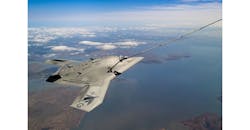FAA Chooses Companies to Assist on Drone Remote IDs
Unmanned aerial systems (UASs), commonly known as drones, will eventually be part of almost every military battlefield. A greater number of UASs will be involved in many other workplaces, however, for consumer, commercial, and industrial applications, such as helping on farms and in warehouses. To keep the skies safe, however, it must be possible to identify each drone, and such is the responsibility of the U.S. Department of Transportation’s Federal Aviation Administration (FAA). The agency recently announced that it had chosen eight companies to help with establishing requirements for the remote identification (remote ID) codes for UAS aircraft so that they can be readily identified and located while flying in U.S. airspace. The eight companies are Airbus, AirMap, Amazon, Intel, OneSky, Skyward, T-Mobile, and Wing. The companies were selected as part of a request for information process conducted in December 2018. As U.S. Transportation Secretary Elaine L. Chao explains: “The FAA will be able to advance the safe integration of drones into our nation’s airspace from these technology companies’ knowledge and expertise on remote identification.”
The numbers of UAS devices and pilots are growing rapidly in the U.S., with a total of more than 1.5 million drones (including commercial and military) already registered and over 170,000 remote drone pilots registered. In addition, over 1 million drones have been registered for recreational use. The new Remote ID technology is being developed simultaneously with a proposed Remote ID rule which will help to maintain safe operating conditions even as the numbers of drones increase so rapidly. The FAA is building on a UAS traffic management (UTM) system and Low Altitude Authorization and Notification Capability (LAANC) that have contributed to the safe use of many smaller drones for different applications. A decade earlier, the majority of UAS applications were for military use. But within the next 10 years, the number of nonmilitary drone applications is expected to far exceed military drone applications.
About the Author
Jack Browne
Technical Contributor
Jack Browne, Technical Contributor, has worked in technical publishing for over 30 years. He managed the content and production of three technical journals while at the American Institute of Physics, including Medical Physics and the Journal of Vacuum Science & Technology. He has been a Publisher and Editor for Penton Media, started the firm’s Wireless Symposium & Exhibition trade show in 1993, and currently serves as Technical Contributor for that company's Microwaves & RF magazine. Browne, who holds a BS in Mathematics from City College of New York and BA degrees in English and Philosophy from Fordham University, is a member of the IEEE.
